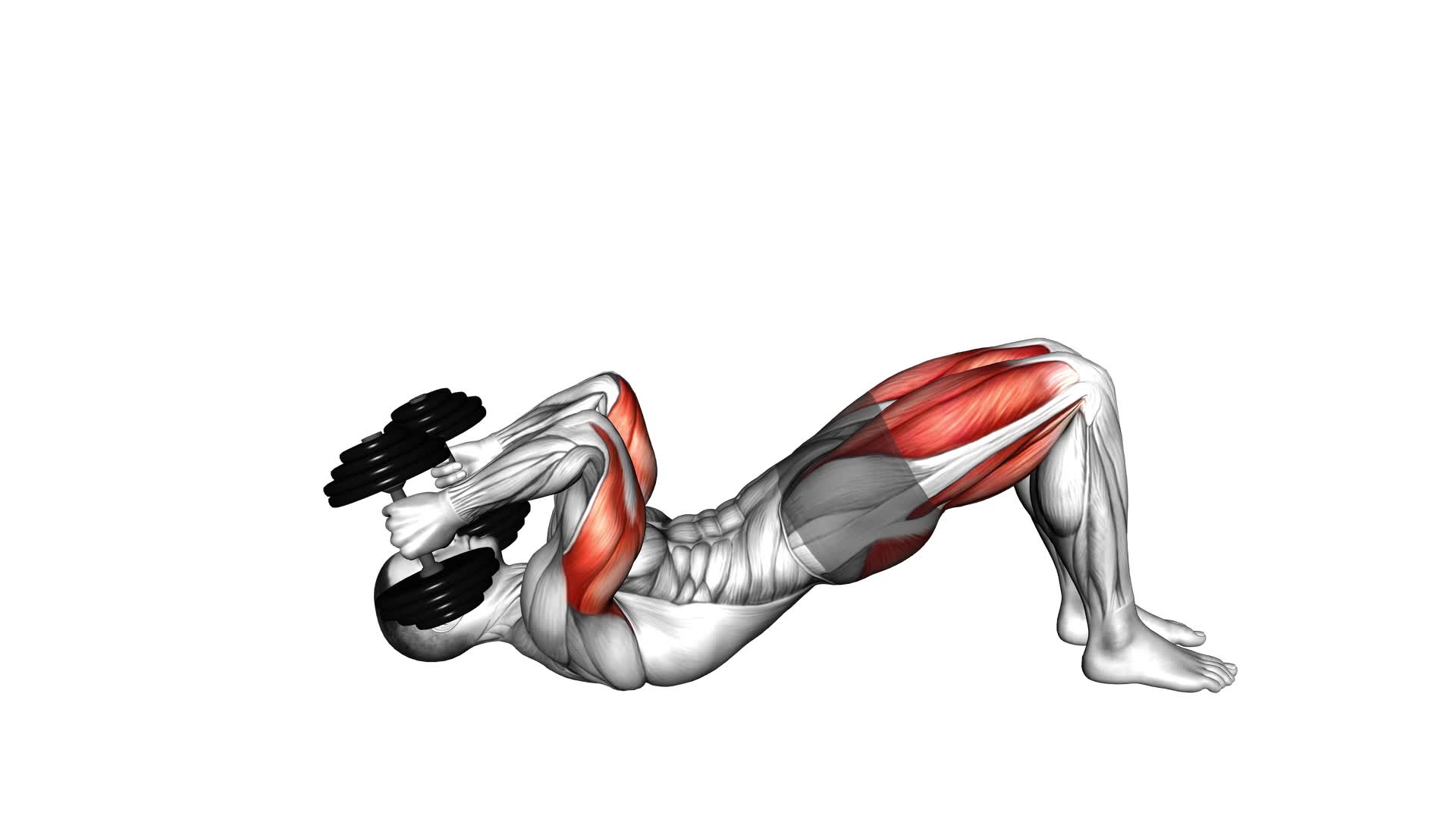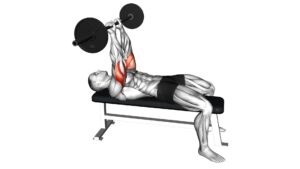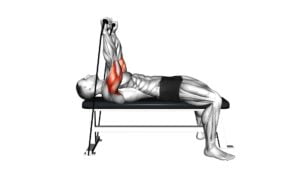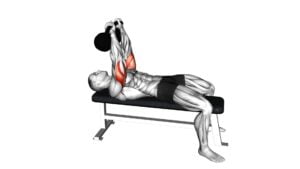Dumbbell Glute Bridge Skull Crusher (male) – Video Exercise Guide & Tips

Are you looking for a challenging and effective exercise to target your glutes and triceps?
Watch This Exercise Video
Look no further than the Dumbbell Glute Bridge Skull Crusher!
This exercise combines the benefits of a glute bridge with a skull crusher, giving you a full-body workout.
In this video exercise guide, we'll show you the proper form, variations to keep things interesting, tips to maximize effectiveness, and common mistakes to avoid.
Get ready to sculpt and strengthen your muscles with this intense exercise.
Key Takeaways
- The dumbbell glute bridge skull crusher targets multiple muscle groups, including the glutes and triceps.
- Proper form is important, including engaging the glutes, maintaining a straight line from knees to shoulders, and keeping the core engaged throughout the movement.
- Variations of the exercise can be done using alternative equipment options like resistance bands, barbells, or kettlebells.
- Progressive difficulty levels can be achieved by increasing the weight of dumbbells, using an unstable surface, or performing the exercise with a single leg.
Benefits of the Dumbbell Glute Bridge Skull Crusher
You should regularly perform the Dumbbell Glute Bridge Skull Crusher to maximize its benefits.
This exercise is effective in targeting multiple muscle groups, providing a wide range of benefits. One of the main advantages of the Dumbbell Glute Bridge Skull Crusher is its ability to activate and strengthen the glute muscles. By performing this exercise, you engage the gluteus maximus, gluteus medius, and gluteus minimus, leading to improved hip stability and power.
Additionally, this exercise also targets the triceps muscles, which are located on the back of the upper arm. By incorporating the Dumbbell Glute Bridge Skull Crusher into your routine, you can effectively tone and strengthen your triceps, enhancing both arm and upper body strength.
Furthermore, this exercise also engages the core muscles, including the abdominals and the lower back muscles. By strengthening these muscles, you can improve stability and support for your spine, reducing the risk of lower back pain and improving overall posture.
Proper Form for the Dumbbell Glute Bridge Skull Crusher
To perform the Dumbbell Glute Bridge Skull Crusher with proper form, follow these steps.
Start by lying on your back with your knees bent and feet flat on the ground.
Hold a dumbbell in each hand, with your arms extended straight up towards the ceiling.
Engage your glutes and lift your hips off the ground, forming a straight line from your knees to your shoulders. This is your starting position.
Next, lower the dumbbells towards your forehead, keeping your elbows pointed towards the ceiling.
Make sure to keep your core engaged and your hips lifted throughout the movement.
Pause for a moment when the dumbbells are close to your forehead, and then slowly extend your arms back up to the starting position.
During this exercise, the glutes are activated to stabilize the hips, while the skull crusher movement targets the triceps and the muscles in the back of the upper arm.
By combining these two movements, you're able to work multiple muscle groups simultaneously, making this exercise efficient and effective.
Now that you know the proper form for the Dumbbell Glute Bridge Skull Crusher, let's move on to the next section to learn about variations that can spice up your workout and provide new challenges for your muscles.
Variations to Spice Up Your Dumbbell Glute Bridge Skull Crusher
To spice up your dumbbell glute bridge skull crusher, there are various alternative equipment options you can try. You can use a barbell, resistance bands, or even a kettlebell to add variety to your workout.
Additionally, you can increase the difficulty level by using heavier weights or adding pauses at different points in the exercise.
Alternative Equipment Options
To add variety to your dumbbell glute bridge skull crusher, consider incorporating different equipment options. Here are some alternative exercises and modifications for beginners that you can try:
- Resistance bands: Attach a resistance band around your thighs or hips to increase the resistance and challenge your glutes even more.
- Barbell: Instead of using dumbbells, use a barbell to perform the skull crusher. This will allow you to lift heavier weights and target your triceps effectively.
- Kettlebells: Hold a kettlebell in each hand and perform the glute bridge skull crusher. The unstable nature of the kettlebells will engage your core and challenge your stability.
- Bodyweight: If you don't have any equipment, you can still perform the exercise using just your bodyweight. This is a great option for beginners to build strength and improve form.
- Stability ball: Place your upper back on a stability ball and perform the skull crusher. This adds an extra element of instability, engaging your core muscles further.
Progressive Difficulty Levels
Increase the intensity of your dumbbell glute bridge skull crusher by incorporating progressive variations to challenge your glutes and triceps even further. There are several progression options you can try to maximize muscle activation during this exercise.
First, you can increase the weight of the dumbbells you use. Start with a lighter weight and gradually work your way up as you become stronger.
Another option is to perform the exercise on an unstable surface, such as a stability ball. This will engage your core muscles and add an extra challenge to the movement.
Finally, you can try performing the exercise with a single leg instead of both legs. This will increase the demand on your glutes and require more stability.
By incorporating these progression options, you can take your dumbbell glute bridge skull crusher to the next level and continue to challenge your muscles.
Now, let's move on to some tips to maximize the effectiveness of this exercise.
Tips to Maximize the Effectiveness of the Dumbbell Glute Bridge Skull Crusher
Engage your glutes and maximize the effectiveness of the dumbbell glute bridge skull crusher by incorporating proper form and adding resistance. Here are some tips to help you get the most out of this exercise:
- Focus on glute activation: Prioritize engaging your glutes throughout the entire movement. Squeeze them at the top of the bridge and maintain tension throughout the skull crusher.
- Use a challenging weight: To increase the effectiveness of the exercise, choose a dumbbell that challenges you without compromising your form. Gradually increase the weight as you get stronger.
- Maintain proper form: Keep your core engaged, back flat on the ground, and heels firmly planted. Avoid arching your back or using momentum to complete the movement.
- Modify for beginners: If you're new to this exercise, start by performing the glute bridge without the skull crusher. Once you have mastered the basic movement, gradually add the skull crusher while maintaining proper form.
- Control the tempo: Slow and controlled movements are key to maximizing the effectiveness of the exercise. Avoid rushing through the reps and focus on feeling the contraction in your glutes.
Common Mistakes to Avoid During the Dumbbell Glute Bridge Skull Crusher
To ensure proper form during the Dumbbell Glute Bridge Skull Crusher, it's important to pay attention to a few key points.
First, make sure your hips are lifted and glutes are engaged throughout the exercise.
Secondly, avoid straining your wrists by keeping them in a neutral position and using a grip that feels comfortable for you.
Proper Form Importance
To perform the Dumbbell Glute Bridge Skull Crusher correctly and avoid common mistakes, it's important to maintain proper form. Proper form is essential for maximizing the effectiveness of the exercise and minimizing the risk of injury. Here are some key points to keep in mind:
- Importance of technique: Focus on the movement and engage the targeted muscles throughout the exercise.
- Muscle activation: Ensure proper glute activation by squeezing your glutes at the top of the bridge and maintaining tension throughout the movement.
- Maintain a neutral spine: Keep your spine in a neutral position, avoiding excessive arching or rounding of the back.
- Control the weight: Maintain control over the dumbbells throughout the exercise, avoiding swinging or using momentum.
- Breathe properly: Inhale during the eccentric (lowering) phase and exhale during the concentric (lifting) phase to maintain core stability.
Avoiding Wrist Strain
To avoid wrist strain during the Dumbbell Glute Bridge Skull Crusher, it's important to maintain proper hand positioning and grip. Improper hand placement can put unnecessary stress on the wrists and increase the risk of injury.
Make sure to grip the dumbbells firmly with your palms facing each other and your wrists in a neutral position. Avoid bending your wrists too much or letting them collapse under the weight of the dumbbells.
Additionally, it's crucial to have strong wrists to prevent injuries. Incorporating wrist strengthening exercises into your routine, such as wrist curls and reverse wrist curls, can help improve wrist stability and reduce the likelihood of strain or sprain during the exercise.
Safety Precautions for the Dumbbell Glute Bridge Skull Crusher
To ensure your safety while performing the Dumbbell Glute Bridge Skull Crusher exercise, always use proper form and start with an appropriate weight. Here are some safety precautions you should keep in mind:
- Warm up: Before starting the exercise, it's important to warm up your muscles to prevent injuries. Spend a few minutes doing dynamic stretches or light cardio to get your blood flowing.
- Maintain proper form: Throughout the exercise, make sure to keep your back flat against the ground and your core engaged. Avoid arching your back or lifting your hips too high, as this can lead to strain or discomfort.
- Start with lighter weights: It's recommended to start with lighter weights and gradually increase the resistance as your strength and technique improve. This will help prevent muscle strains or other injuries.
- Use a spotter: If you're using heavy weights or are unsure about your form, it's a good idea to have a spotter nearby. They can provide assistance if needed and ensure your safety during the exercise.
- Listen to your body: Pay attention to how your body feels during the exercise. If you experience any pain or discomfort, stop immediately and consult a fitness professional or healthcare provider.
Frequently Asked Questions
How Much Weight Should I Use for the Dumbbell Glute Bridge Skull Crusher?
To determine the appropriate weight for the dumbbell glute bridge skull crusher, consider your current fitness level and strength. Start with a weight that challenges you but allows for proper form and technique. Gradually increase the weight as you become more comfortable and proficient with the exercise.
The dumbbell glute bridge skull crusher offers numerous benefits, such as targeting the glutes, hamstrings, and triceps. Variations include using a barbell or resistance bands for added intensity.
Can I Perform the Dumbbell Glute Bridge Skull Crusher Without a Bench?
Yes, you can still perform the dumbbell glute bridge skull crusher without a bench. There are modifications you can try to make it work for you.
You can use a stability ball or yoga block as a substitute for the bench.
Additionally, there are alternative exercises you can do to target similar muscle groups, such as hip thrusts or lying tricep extensions.
Remember to adjust the weight according to your strength level.
How Often Should I Incorporate the Dumbbell Glute Bridge Skull Crusher Into My Workout Routine?
To determine how often you should incorporate the dumbbell glute bridge skull crusher into your workout routine, consider factors such as your fitness goals, current fitness level, and recovery abilities.
It's generally recommended to perform this exercise 2-3 times per week, allowing for proper rest and recovery between sessions.
Additionally, you can vary the intensity by adjusting the weight or adding different variations of the exercise to target different muscle groups.
Can I Replace the Dumbbells With a Barbell for the Dumbbell Glute Bridge Skull Crusher?
Yes, you can replace the dumbbells with a barbell for the dumbbell glute bridge skull crusher.
This variation of the exercise can provide a different challenge and target your muscles in a slightly different way.
Using a barbell allows you to lift heavier weights and engage more muscle groups.
Just make sure to maintain proper form and start with a weight that you can handle safely.
Should I Feel Any Discomfort in My Lower Back During the Dumbbell Glute Bridge Skull Crusher?
Lower back discomfort during the dumbbell glute bridge skull crusher isn't ideal. It could indicate improper form or excessive weight. Focus on maintaining proper alignment and engaging your glutes throughout the exercise.
Ensure that your lower back stays neutral and doesn't round or arch excessively. If you continue to experience discomfort, consider reducing the weight or consulting a fitness professional for guidance.
Proper glute activation should be the primary focus of this exercise.
Conclusion
In conclusion, the dumbbell glute bridge skull crusher is an effective exercise for targeting the glutes and triceps.
By maintaining proper form and incorporating variations, you can maximize the effectiveness of this exercise.
However, it's important to avoid common mistakes and take necessary safety precautions to prevent injury.
With the right technique and consistency, this exercise can help you strengthen and tone your muscles.

Author
Years ago, the spark of my life’s passion ignited in my mind the moment I stepped into the local gym for the first time. The inaugural bead of perspiration, the initial endeavor, the very first surge of endorphins, and a sense of pride that washed over me post-workout marked the beginning of my deep-seated interest in strength sports, fitness, and sports nutrition. This very curiosity blossomed rapidly into a profound fascination, propelling me to earn a Master’s degree in Physical Education from the Academy of Physical Education in Krakow, followed by a Sports Manager diploma from the Jagiellonian University. My journey of growth led me to gain more specialized qualifications, such as being a certified personal trainer with a focus on sports dietetics, a lifeguard, and an instructor for wellness and corrective gymnastics. Theoretical knowledge paired seamlessly with practical experience, reinforcing my belief that the transformation of individuals under my guidance was also a reflection of my personal growth. This belief holds true even today. Each day, I strive to push the boundaries and explore new realms. These realms gently elevate me to greater heights. The unique combination of passion for my field and the continuous quest for growth fuels my drive to break new ground.







